19 Types of Ducks Found in Montana (With Pictures)
Last Updated on
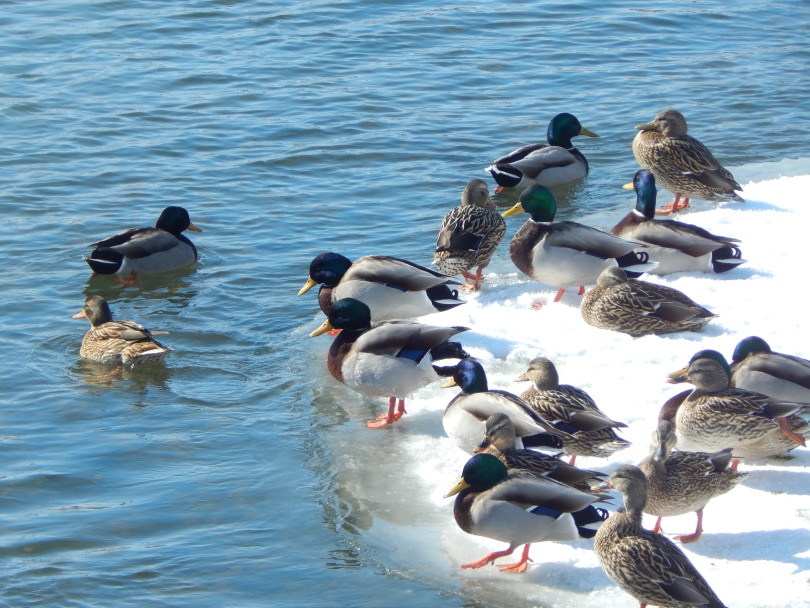
Ducks are those cute animals seen swimming around in almost all types of water habitats. While some of them are habitual to water, others live without it.
You’ll be surprised to know that “ducks” is a common term used for several waterfowl species in the Anatidae family. Unlike geese and swans, ducks are smaller animals with shorter necks.
The US hosts multiple duck breeds in almost every state. Montana holds a special place, as it hosts large numbers of various duck species.
So, whether you want to discover different duck breeds in Montana or hunt a few, you’re at the right place. This post will list the 19 species of ducks in Montana in detail.

The 19 Species of Ducks Found in Montana
On your next trip to Montana, invest your time in spotting these 19 duck breeds:
1. Mallard Ducks

| Type | Dabbler |
| Lifespan | 5–10 years |
| Migration | Yes |
Mallard is the most common bird species in Montana and other parts of the US. Even though everyone knows these ducks, male and female Mallards are pretty different in appearance.
The males have a striking bright green head with a thin white collar and a yellow bill. Meanwhile, females are brown and have orange and brown bills. In addition, when male and female Mallards stand or fly, you’d see that both have purple-blue secondary feathers on their wings.
Mallards are friendly and social ducks, which usually enjoy people’s attention. Their favorite habitat is water, whether a swimming pool, pond, or lake.
Female Mallards have a loud quacking sound, while males don’t quack but have a raspy call.
2. Gadwall Ducks

| Type | Dabbler |
| Lifespan | 20–28 years |
| Migration | Yes |
Gadwalls are primarily found in smaller ponds surrounded by lots of vegetation. This duck breed is famous for its funny habit of stealing meals from diving ducks, especially American Coots.
Male Gadwalls have feathers in gray, black, and brown colors, which give the impression of white-fringed scales. They have a brown head with a dark gray or black bill. Meanwhile, the female Gadwalls are brown and have a dark orange and black bill, like female Mallards. You can identify Gadwalls by a white patch on their wings that becomes visible when they fly.
If you mostly go to parks and hear a loud burp from the pond, it could be a male Gadwall. These are not actual burps but, rather, short calls. Females have a more high-pitched quacking sound.
3. American Wigeon
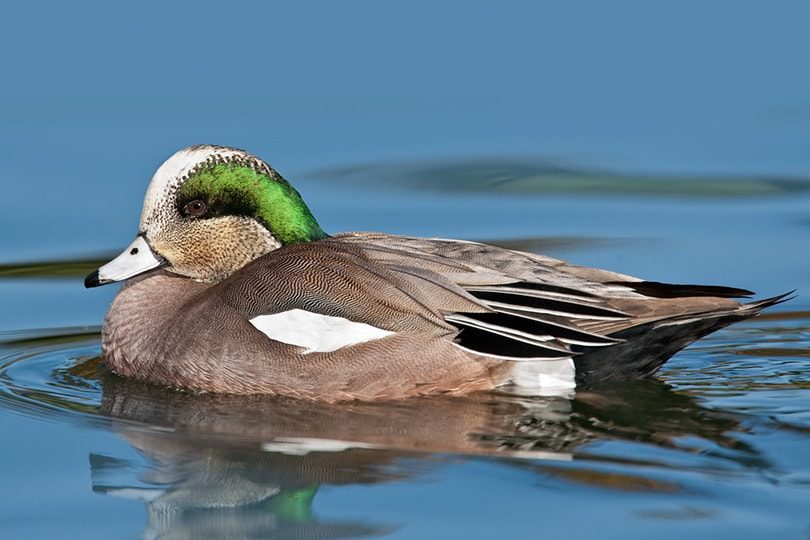
| Type | Dabbler |
| Lifespan | 2 years |
| Migration | Yes |
You may think of this duck breed as something rare. However, that is not true. American Wigeons are present in large numbers around the world, but they primarily reside in quiet water habitats with less human presence.
These small ducks have round heads and blue-gray bills with a black hint on the tip. Males are mostly brown with a green band on the back of their eyes and a white crown. In contrast, females are also brown but have gray heads. American Wigeons’ short bills help them grab and pluck vegetation easily. They love to feed on plant matter, so they often enter farm fields for nutrition.
Males produce a three-part whistle that sounds like a kazoo or “whew-whew-whew.” Females, on the other hand, produce harsh quacks.
4. Northern Pintail
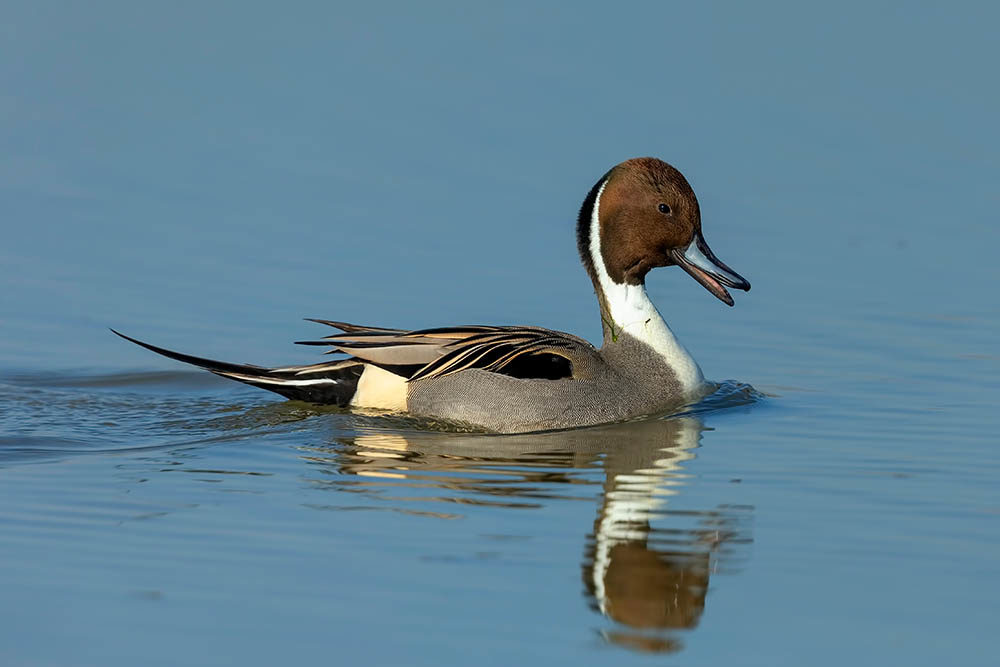
| Type | Dabbler |
| Lifespan | 22 years |
| Migration | Yes |
Northern Pintails are long-necked ducks that prefer to live in wetland habitats with fewer humans around. They also have long tails and a black-gray bill. Northern Pintails like shallower areas, particularly near the lakes and ponds.
Males are identified by brown heads and gray bodies with white-colored breasts and throats. Meanwhile, females have tan heads and brownish plumage on their entire bodies. Their long, pointed tails become more visible when the ducks fly or float on water.
Northern Pintails also thrive on dry surfaces. Many people use this duck breed to clean farm fields of wheat, corn, or rice remains.
In addition, they are some of the best flyers. You’ll be surprised to know that they can even reach speeds as high as 48 miles per hour during migration.
The males make a unique, train-like whistle sound, while the females produce low-pitched quacks.
5. Northern Shoveler

| Type | Dabbler |
| Lifespan | 18 years |
| Migration | Yes |
People often confuse Northern Shovelers with Mallards because of their green heads. But if you look closely, you’ll see that these ducks have a massive spoon or shovel-shaped bill that sets them apart from Mallards. This also explains the name of this duck breed.
Northern Shovelers used their enormous bills to shovel through the mud and find delicious snacks like mollusks and buried aquatic creatures. Surprisingly, their bills have more than 100 tiny projections around the edges, known as lamellae, that filter the duck’s food.
Males have brownish-red flanks, white chests, green heads, yellow eyes, and black backs. On the other hand, females are brown with a bluish patch on the shoulders. Both genders have different bills, but they are large and wide.
When mating or alarmed, male Northern Shovelers produce a “took-took” sound, while females have a normal sounding quack.
6. Blue-Winged Teal
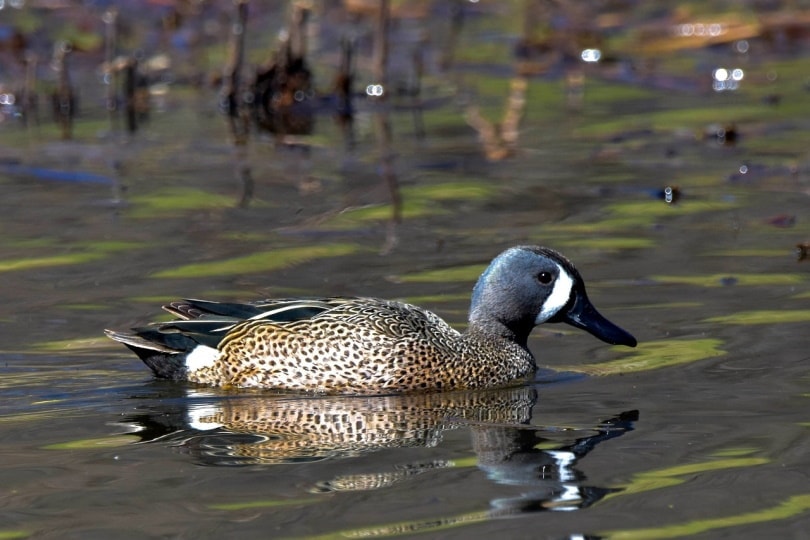
| Type | Dabbler |
| Lifespan | 17 years |
| Migration | Yes |
Blue-Winged Teals are beautiful ducks with a blue shoulder patch that becomes visible when flying. Adding to their beauty, the wings of these ducks also have a green plumage below the blue. You’re most likely to find these ducks in shallow water habitats throughout Montana.
This duck breed is one of the most easily found in North America, following the Mallard. Males have bluish heads with a white band on the front of their eyes. They also have black bills and wings and brown bodies with black spots. On the other hand, females are brown with a dark eye line and head crown.
7. Common Goldeneye

| Type | Diving |
| Lifespan | 15–20 years |
| Migration | Yes |
Common Goldeneyes are seasoned diving ducks in Montana with an impressive characteristic of staying underwater for more than a minute. They primarily search for food in the water and eat fish, invertebrates, eggs, seeds, and submerged vegetation.
You can identify the male Common Goldeneyes by their gorgeous dark-green head, white patch on their cheeks, and bright-yellow eyes. Females, on the other hand, are gray with brown heads and shorter, darker bills with yellow tips. They have pale-yellow eyes and white-colored neck collars.
The wings of these ducks make a distinctive whistling noise in flight. However, both sexes are usually silent, except when mating.
8. Green-Winged Teal
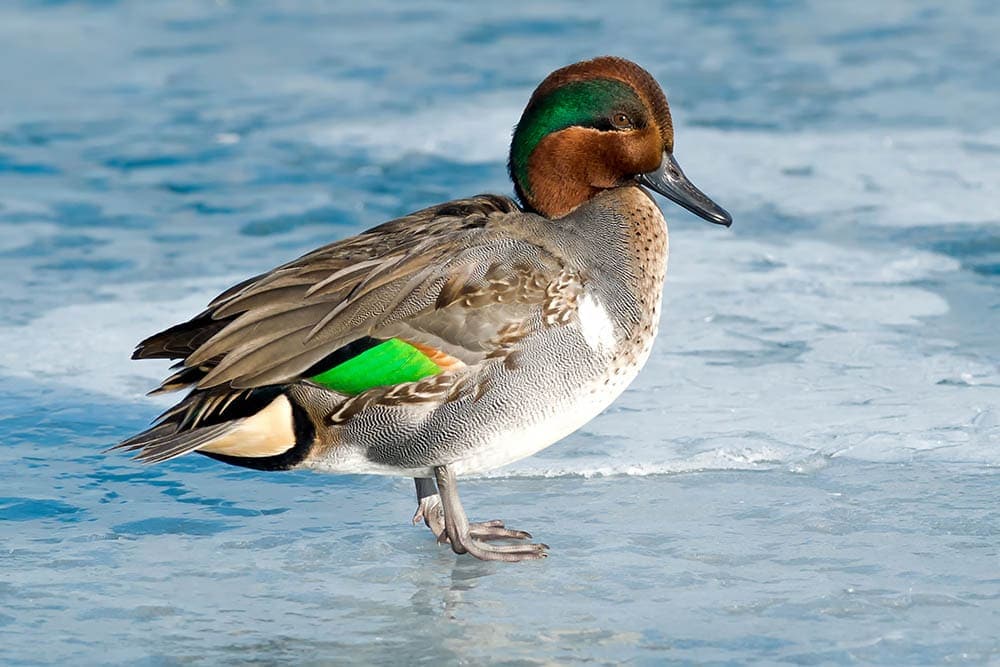
| Type | Dabbler |
| Lifespan | 27 years |
| Migration | Yes |
True to their name, Green-Winged Teals are compact ducks in Montana with a distinctive green patch on their wings. They measure only 12–15 inches in length and weigh between 5–18 ounces. These ducks are social, so you’ll often find them spending time with other breeds.
You can quickly identify these birds in flocks by looking for the smallest ducks. Besides, males are gray with vertical, white-colored stripes on both sides. They have chestnut-brown heads and a green patch on their ears. Females are mottled brown with a dark eye line.
Green-Winged Teals are found in Montana in abundance. Males produce a short, crisp, and repeated whistle that is not like the sound of any other duck breed. Females make a series of quacks.
9. Wood Duck
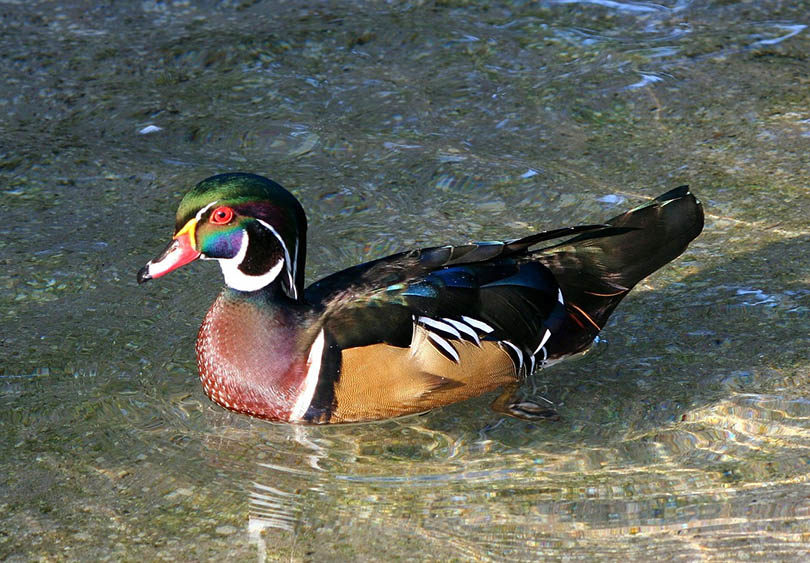
| Type | Dabbler |
| Lifespan | 3–5 years |
| Migration | Yes |
Wood Ducks are a delight to the eyes. These ducks have got almost all shades on their bodies—green, lime, orange, buff, rose, brown, black, gray, purple, blue, white, and yellow.
A fun fact about Wood Ducks is that they even live in trees! They use tree cavities to build their nests, which has contributed to their evolution. Newer Wood Duck breeds have powerful claws that help them grasp and perch onto different tree branches.
You can identify males with their distinctive plumage. They have green-crested heads, red eyes, and chestnut bodies adorned with white dots. Females are brown and have gray heads that are slightly crested like males. You can detect a female Wood Duck with a teardrop eye patch and blue wing patch.
When annoyed, Wood Ducks make “ooeek-ooeek” loud sounds.
10. Redhead
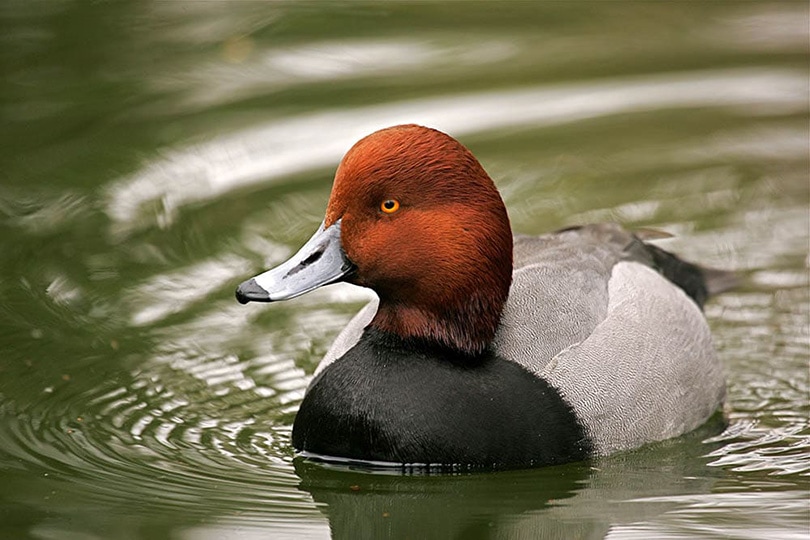
| Type | Diving |
| Lifespan | 20 years |
| Migration | Yes |
Redheads love Montana’s winter season as they are primarily seen in flocks when the weather starts to get cold. These sociable ducks mostly prefer swimming on larger lakes and are identified by their steep foreheads that go down to their gray bills with black tips.
Males are gray with black chests and have cinnamon-red heads with yellow eyes, while females are brownish with dark eyes.
An interesting thing about Redheads is that they are inclined toward brood parasitism. This means they lay a significant portion of their eggs in other ducks’ nests and let them care for those hatchlings. Common species stuck raising their young often include Mallards, Northern Pintails, Gadwalls, and Ruddy Ducks. Sometimes, they may also build their nests and raise their hatchlings themselves.
11. Cinnamon Teal

| Type | Dabbler |
| Lifespan | 10 years |
| Migration | Yes |
Cinnamon Teals are another abundant duck breed in Montana. They are more commonly spotted in large wetlands, mainly around the edges of vegetation that serve as the animal’s cover. Unfortunately, their population has been slowly declining over the past few decades.
You can identify the male Cinnamon Teals from their cinnamon-colored body with a wide, long black bill and red eyes. Meanwhile, females are mottled brown and have large black bills and black eyes.
When these ducks fly, the beautiful blue and green patches on their wings become more visible. Males produce a low-pitched “karr, karr, karr” sound that is quite unpleasant to the ears. Females are very protective of their ducklings and can even fight predators.
12. Bufflehead
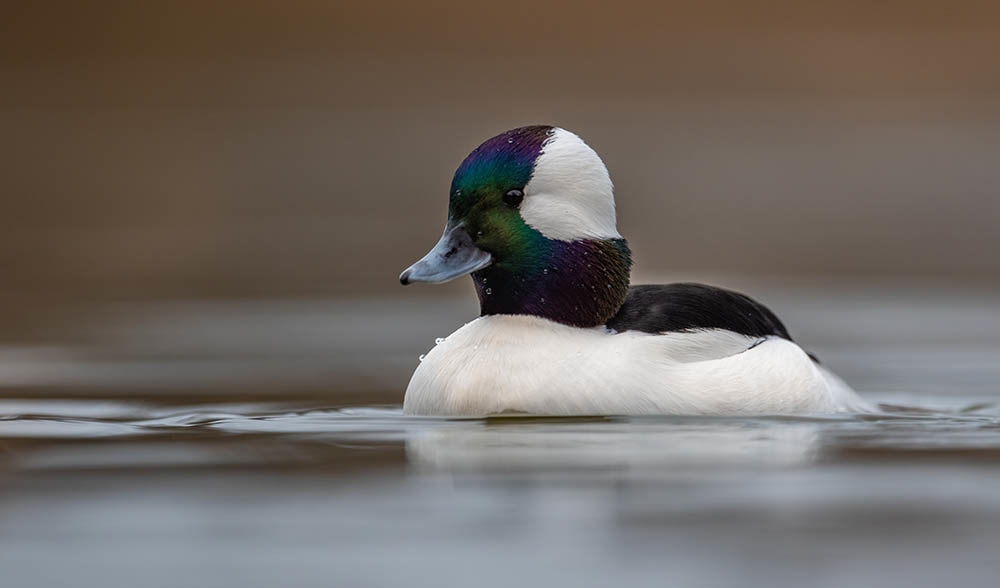
| Type | Diving |
| Lifespan | 2.5 years |
| Migration | Yes |
It’s not often that you’ll spot these cute little buffy ducks in Montana since they spend almost half of their lives underwater. They do so to find their food, such as aquatic invertebrates and crustaceans. Buffleheads are compact ducks with big heads.
Males have white chests and a large white patch on their heads. Their bodies are dark black, while some may have purple-green plumage on their faces. Female Buffleheads are mostly brown with a dark head and a distinctive white patch on the cheek.
When it comes to making sounds, Buffleheads are usually silent, but the males may make squeaky whistles in early spring or late winter.
13. Canvasback
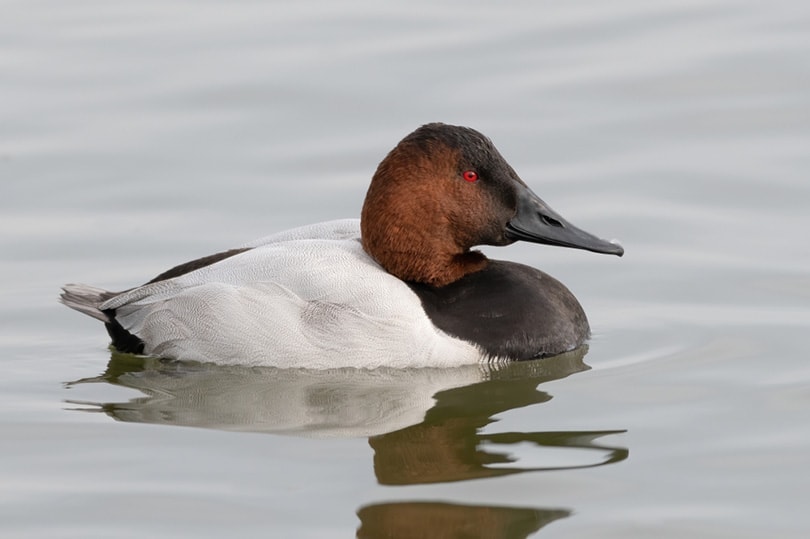
| Type | Diving |
| Lifespan | 16–22 years |
| Migration | Yes |
Canvasbacks are large-sized ducks that don’t even go close to the land. Yet, surprisingly, these ducks love wetlands so much that they sleep while floating on the water and even nest in masses of vegetation present on the water’s surface.
This duck breed is omnivorous, so they feed on insects, seeds, and plants. They have an impeccable diving capacity that allows them to dive up to several feet deep to find the right type of vegetation underwater.
These are larger diving ducks with black-colored chests and tails and gray bodies. Their heads are shaped in a wedge style that slopes down to their long bill. Males have red-brown heads with distinctive red eyes, while females have brown heads with black eyes.
14. Ruddy Duck

| Type | Diving |
| Lifespan | 2–13 years |
| Migration | Yes |
Identified by their distinctive blue bills, Ruddy Ducks are another impressive duck breed that is hard to miss.
The blue color isn’t the only unique thing about their bills—male Ruddy Ducks use their bills to attract females for mating. They do so by beating their bill on their neck with so much force that it forces air to come out through their feathers. This creates a swirl of water bubbles supported by a belch-like sound that female Ruddy Ducks love.
Males are chestnut-colored with blue bills, white cheeks, and black caps. Their stiff black tail is usually erect. On the other hand, females are soft brown and have darker caps. Non-breeding males and females have scoop-like, black-colored bills instead of blue.
Ruddy Ducks prefer swimming instead of flying, even when predators attack them.
15. Common Merganser
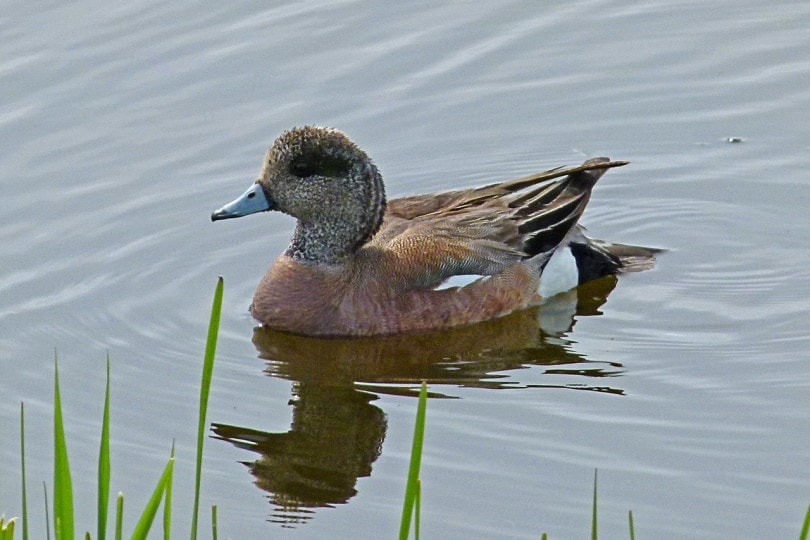
| Type | Diving |
| Lifespan | 10-13 years |
| Migration | Yes |
It’s easier to identify Common Mergansers than other ducks in Montana because of their thin bills. These are relatively large ducks with long, delicate, orange-colored bills with black tips and dark eyes.
Breeding males have a large white body that is black from the back. In addition, they have mallard-like, green-colored heads. Females and non-breeding males, on the other hand, have cinnamon-colored heads and whitish-gray bodies.
Common Mergansers love to catch and eat fish. They use their serrated bills to easily catch their prey, including mollusks, insects, crustaceans, and worms. This duck breed is an expert in fishing to the extent that many other ducks steal food from them when they come up to the water surface. In fact, you may often see seagulls chasing these ducks to snatch some fish out of their bills.
16. Hooded Merganser
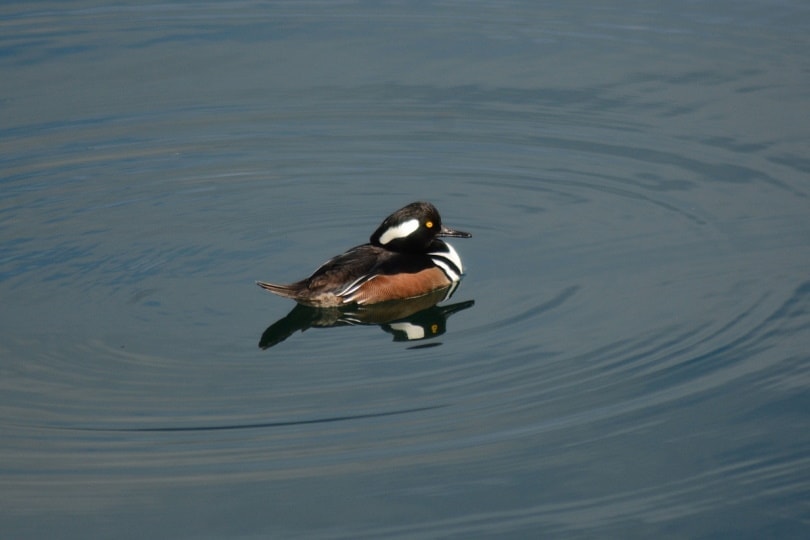
| Type | Diving |
| Lifespan | 12 years |
| Migration | Yes |
The Hooded Merganser is a small duck breed with long, thin bills. Their distinctive bills help them easily catch small sea creatures, such as fish, crayfish, and other insects. These ducks usually swallow their food, regardless of how big or small it is. Since they’re diving ducks, they mostly search for their food underwater.
This duck breed is mostly found in shallow ponds in summers, while they move to live in unfrozen lakes in winter. You can identify the males by their large black crest with a big white patch on both sides. They also have yellow eyes.
Females are brown with a lighter crest and darker eyes. And yes, they do look like they have a mohawk. The female Hooded Mergansers may also lay a significant portion of their eggs in other Hooded Mergansers’ nests.
17. Ring-Necked Duck

| Type | Diving |
| Lifespan | 5–10 years |
| Migration | Yes |
You may be wrong if you think that Ring-Necked Ducks would have visible rings around their necks. Yes, the name of this duck is quite misleading, as the so-called rings are so pale that you can’t even spot them.
Ring-Necked Ducks thrive in shallow ponds and wetlands. These ducks come together in flocks as the weather becomes colder. However, in the breeding season, you may only detect two or three of them together.
These medium-sized ducks have a pointed head and a gray bill adorned with a white band and black tip. Males have a glossy black head, chest, and yellow eyes, while females are brown with gray throat and face.
One sad fact about this duck breed is that they have been seen eating leftover shotgun pellets. Of course, this makes them prone to lead poisoning. But fortunately, lead shots are now almost banned in most parts of the US.
18. Red-Breasted Merganser

| Type | Diving |
| Lifespan | 1–8 years |
| Migration | Yes |
Red-Breasted Mergansers primarily breed in boreal forests in most parts of North America, so you may find them on several inland lakes. In addition, this duck breed migrates towards the south to spend their time away from the coast in the winter season.
These are slim ducks with long, slender necks and thin bills. They mostly munch on fish as their primary source of food.
Males are identified with their distinctive cinnamon-colored chest, dark-green heads with pointed crests, and red eyes. Meanwhile, females and non-breeding males have grayish-brown bodies.
19. Harlequin Duck
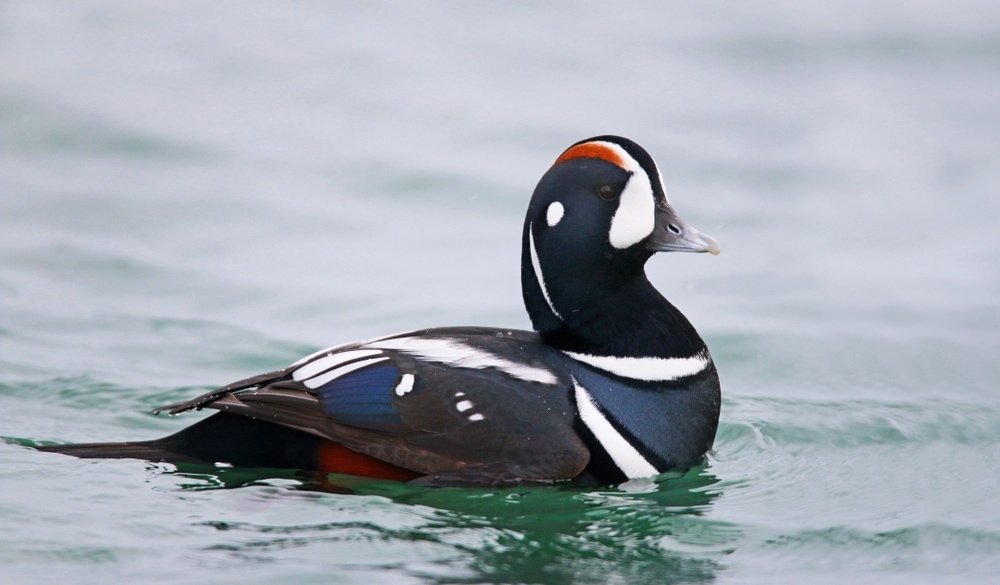
| Type | Diving |
| Lifespan | 9–12 years |
| Migration | Yes |
These are, so far, the most gorgeous ducks you’ll find in Montana. Harlequin Ducks have a striking color palette consisting of beautiful blue, white, and chestnut shades. They are compact with a short, dark gray bill.
Breeding males have darker, bluish bodies with rust-brown patches on both sides. They also have white spots on their necks and bodies and a white crescent on their faces. On the other hand, females are brown with white spots behind their eyes and bills.
Harlequin Ducks prefer breeding alongside rivers. However, they migrate to rocky ocean edges in winters. These ducks are quite vocal, but their noise is not like other species. You may burst into laughter by hearing their cute, mouse-like squeaking. This is why they are also known as the sea mouse.

What Are the Two Most Common Types of Ducks?
Montana is home to the two most common types of ducks:
Dabbling Ducks
These ducks dive headfirst into the water with their pointed tails sticking out to feed on greens and invertebrates present in the shallows. Dabbling ducks don’t only rely on water inhabitants for their nutrition. Instead, they also eat seeds and leftover grains from farm fields in winter.

Diving Ducks
These ducks completely submerge themselves under the water to catch fish and invertebrates more easily. This is why diving ducks usually have small, narrow, and pointed wings that allow them to swim better.
Unlike dabblers, these ducks can’t actually take off from the water surface as smoothly. So, you may find them running on the water surface to develop enough speed to move.

Conclusion
Ducks are the kind of animals that like to float on the water while minding their own business. However, they may become aggressive if you provoke them.
So, whether you’re a seasoned hunter looking to feast on a tasty duck or just a duck lover living in Montana, know that the state is home to breath-taking duck breeds worldwide. Starting from Mallards to Harlequin Ducks, Montana will not disappoint you!
Featured Image Credit: Piqsels
Table of Contents
- The 19 Species of Ducks Found in Montana
- 1. Mallard Ducks
- 2. Gadwall Ducks
- 3. American Wigeon
- 4. Northern Pintail
- 5. Northern Shoveler
- 6. Blue-Winged Teal
- 7. Common Goldeneye
- 8. Green-Winged Teal
- 9. Wood Duck
- 10. Redhead
- 11. Cinnamon Teal
- 12. Bufflehead
- 13. Canvasback
- 14. Ruddy Duck
- 15. Common Merganser
- 16. Hooded Merganser
- 17. Ring-Necked Duck
- 18. Red-Breasted Merganser
- 19. Harlequin Duck
- What Are the Two Most Common Types of Ducks?
- Conclusion
About the Author Jeff Weishaupt
Jeff is a tech professional by day, writer, and amateur photographer by night. He's had the privilege of leading software teams for startups to the Fortune 100 over the past two decades. He currently works in the data privacy space. Jeff's amateur photography interests started in 2008 when he got his first DSLR camera, the Canon Rebel. Since then, he's taken tens of thousands of photos. His favorite handheld camera these days is his Google Pixel 6 XL. He loves taking photos of nature and his kids. In 2016, he bought his first drone, the Mavic Pro. Taking photos from the air is an amazing perspective, and he loves to take his drone while traveling.
Related Articles:
Monocular vs Telescope: Differences Explained (With Pictures)
10 Types of Hummingbirds in Arkansas (With Pictures)
8 Types of Hummingbirds in Nebraska (With Pictures)
5 Types of Hummingbirds in Idaho (With Pictures)
3 Types of Hummingbirds in Mississippi (With Pictures)
8 Types of Hummingbirds in Kansas (With Pictures)
5 Types of Hummingbirds in West Virginia (With Pictures)
5 Types of Hummingbirds in Ohio (With Pictures)
